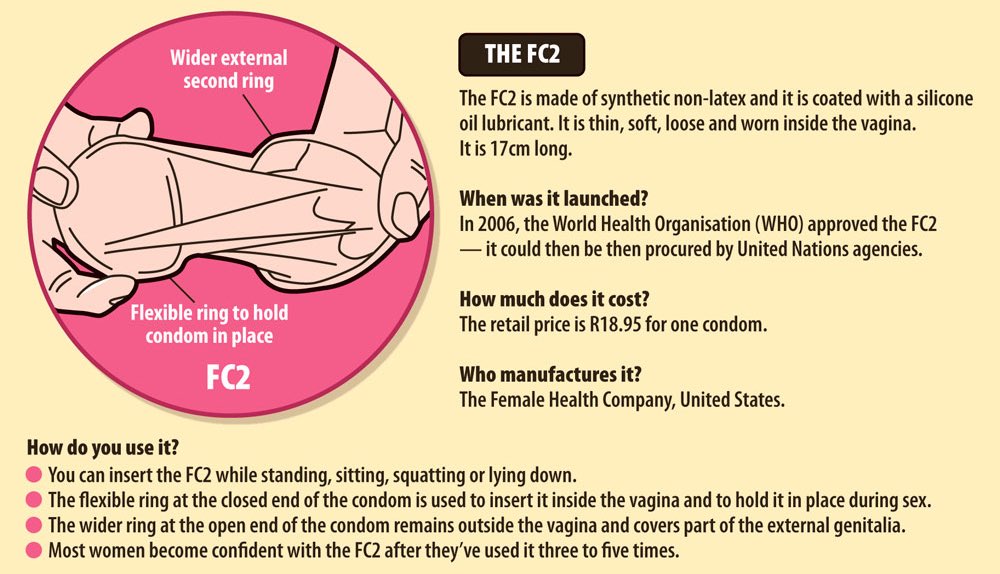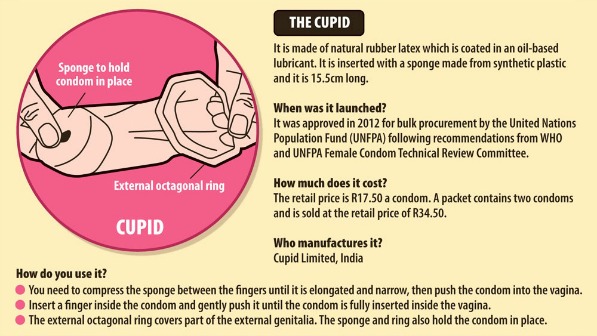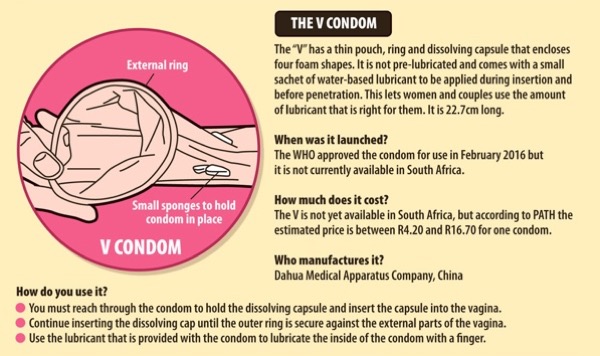South Africa is pumping more money into female condom distribution. We look at what’s on the market and what’s to come for the femidom.
The South African department of health is making female condoms more available. The government has already distributed 26-million of the condoms in this financial year, exceeding its own targets. By March 2017, the country aims to put four-million more femidoms in women’s hands. As South Africa ramps up availability of the female sheaths, we take a look at the past, present and future of the female condom.

The Lovers Plus Inner Condom (FC2)
The Lovers Plus Inner Condom (FC2) is made of synthetic non-latex and it is coated with a silicone oil lubricant. The 17cm-long condom is thin, soft and loose.
Launched: In 2006, the World Health Organisation (WHO) approved the FC2 — it could then be then procured by United Nations agencies.
Cost: The retail price is R18.95 a condom.
Manufacturer: The Female Health Company, United States.
How to use it: Insert the condom while standing, sitting, squatting or lying down. Squeeze the flexible ring at the closed end of the condom and then push it inside the vagina. This ring holds the condom in place during sex. The wider ring remains outside the vagina and covers part of the external genitalia. Most women become confident with the Lovers Plus Inner Condom after they’ve used it three to five times.

The Cupid
The Cupid is 15.5cm long and is made of natural rubber latex, which is coated in an oil-based lubricant.
Launched: It was approved in 2012 for bulk procurement by the UN Population Fund following recommendations from that body’s female condom technical review committee and the WHO.
Cost: The retail price is R17.50 a condom. A packet contains two condoms, which is sold at the retail price of R34.50.
Manufacturer: Cupid Limited, India
How to use it: Compress the circular sponge inside the condom between your fingers until it is elongated and narrow and then gently push it until the condom is fully inserted inside the vagina. The external octagonal ring covers part of the external genitalia. The sponge and ring hold the condom in place.

The V
The V has a thin pouch, ring and dissolving capsule that encloses four foam shapes. It is not prelubricated and instead comes with a sachet of water-based lubricant to be applied during insertion and before penetration. This lets people use the amount of lubricant that is right for them. The V is 22.7 cm long.
Launched: The condom was recently approved by the World Health Organisation (WHO), but is currently not available in the public or private sector.
Cost: The V is not yet available at retail outlets, but according to PATH, an international non-profit that deals with public health innovations, the estimated price is between R4.20 and R16.70 a condom.
Manufacturer: Dahua Medical Apparatus Company, China
How to use it: Reach through the condom to hold the dissolving capsule and insert the condom into the vagina. Continue inserting the condom, until the outer ring is secure against the external parts of the vagina. Spread the lubricant the inside the condom with a finger.
Graphics: John McCann
Sources: The Female Company (FC2 Female Condom FAQs), Reproductive Health Matters (New condoms in the pipeline) and PATH Protection Options for Women Product Development Partnership (POW PDP)
This article was amended on 7 September 2016. The story originally stated that the V condom had not yet been approved for use by the World Health Organisation. The condom was approved by the body in February 2016.
Pontsho Pilane is the communications manager at Soul City Institute for Social Justice. Pilane was a health journalist at Bhekisisa from 2017 until 2019.





